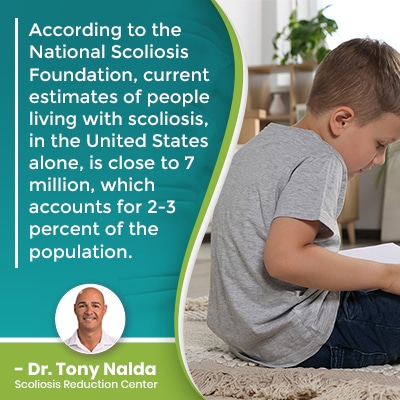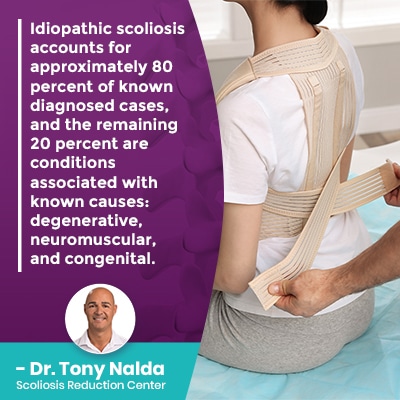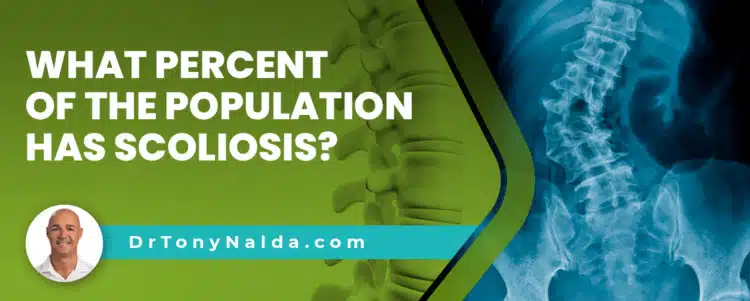Scoliosis affects all ages, races, genders, ranges widely in severity, and has different condition types. While most commonly diagnosed in children and adolescents, the actual rate of scoliosis increases as the population ages; continue reading to better understand scoliosis and its prevalence.
While most people have heard of scoliosis, few realize how prevalent it is. Scoliosis is a structural spinal condition with current estimates at approximately 7 million people currently diagnosed in the United States alone, and is the most-prevalent spinal condition amongst school-aged children.
Scoliosis is a fascinating condition that’s been around for hundreds of years, so let’s start with what it means to be diagnosed with scoliosis.
What is Scoliosis?
The spine is a key structure when it comes to maintaining health and wellness; not only does it allow us to stand upright and practice good posture, it enables flexible movement, and works in tandem with the brain to form the central nervous system (CNS).
The central nervous system is a complex network of nerves that sends signals and messages to and from the brain and the rest of the body.
As the central nervous system is involved in the function of virtually every working system within the body, spinal conditions can cause a wide range of effects that can vary from person to person.
Scoliosis is an unnatural spinal curve that bends to the side, and rotates, making it a 3-dimensional condition.
Based on a measurement known as Cobb angle, conditions are classified by severity:
Mild scoliosis: Cobb angle measurement of between 10 and 25 degrees
Moderate scoliosis: Cobb angle measurement of between 25 and 40 degrees
Severe scoliosis: Cobb angle measurement of 40+ degrees
Very-severe scoliosis: Cobb angle measurement of 80+ degrees
Being diagnosed with scoliosis means living with a progressive condition; scoliosis has it in its nature to worsen over time, so how severe a patient’s scoliosis is at the time of diagnosis is not indicative of where it will stay.
Only proactive treatment can counteract the condition’s progressive nature, and different treatment approaches offer patients different potential outcomes.
So now that we’ve defined scoliosis and discussed some general condition characteristics, let’s talk numbers, as in the percentage of the population that has scoliosis.
What Percent of People Have Scoliosis?

According to the National Scoliosis Foundation, current estimates of people living with scoliosis, in the United States alone, is close to 7 million, which accounts for 2-3 percent of the population.
And keep in mind that these estimates are only referencing known diagnosed cases, and only those living within the United States; if we were to add to that number, undiagnosed cases, and cases from around the world, that number would increase exponentially.
When it comes to Americans living with spinal conditions, scoliosis accounts for approximately 20 percent, and scoliosis is the leading spinal condition amongst school-aged children.
It’s estimated that more than 600,000 yearly doctor’s visits are related to scoliosis, and an approximate 30,000 children are fitted with scoliosis braces.
Approximately 133,300 visits to the hospital and 17,500 visits to the emergency room are made yearly by children with scoliosis.
So when it comes to how much of the population has scoliosis, in the United States, we’re talking about 2-3 percent, and an important factor to understand is that there isn’t just one type of scoliosis, and instead, there are multiple different types of scoliosis a person can develop.
Different Types of Scoliosis
Scoliosis not only ranges widely in severity from mild to moderate and severe to very severe, but also in type.
Different types of scoliosis have unique symptoms, progressive rates, and treatment needs, and also different prevalence rates; let’s start with the most common type of scoliosis diagnosed.
Idiopathic Scoliosis
The most prevalent form of scoliosis to be diagnosed is adolescent idiopathic scoliosis (AIS), diagnosed between the ages of 10 and 18.
The idiopathic designation means we don’t fully understand what triggered the condition’s development (although there is no shortage of theories), and idiopathic scoliosis is also the most common type to affect adults.
Cases of idiopathic scoliosis in adults are adolescents whose scoliosis wasn’t diagnosed or treated during adolescence, and this is quite common as adolescent idiopathic scoliosis isn’t always painful, and particularly in mild cases, its symptoms are subtle and can be dififcult for an average person to notice.
Scoliosis becomes compressive when skeletal maturity is reached, and as it’s compression of the spine, and its surrounding nerves and muscles, that causes the majority of condition-related pain, this is the time when many cases are first diagnosed: when they start producing noticeable symptoms like pain.

Idiopathic scoliosis accounts for approximately 80 percent of known diagnosed cases, and the remaining 20 percent are conditions associated with known causes: degenerative, neuromuscular, and congenital.
Degenerative Scoliosis
Also known as adult do novo scoliosis, unlike idiopathic scoliosis in adults, degenerative scoliosis develops fresh in adulthood with no prior history of the condition.
Degenerative scoliosis is common in adults over the age of 40 and is caused by natural age-related spinal degeneration; however, certain lifestyle factors (obesity, low activity levels, chronic poor posture, and not lifting heavy objects correctly) can increase, or decrease, rates of spinal degeneration.
More prevalent in females, this is thought to be the result of bone density/hormone changes caused by menopause.
While progressive rates tend to slow once the trigger of growth is removed, once spinal degeneration comes into play, this can change, and studies show that the actual rates of scoliosis increase with age.
While adolescent idiopathic scoliosis diagnoses are made in approximately 4 out of 100 adolescents, studies have shown that the rate of scoliosis in adults is between 12-20 percent; in fact, one study looking at the prevalence of scoliosis in adults over the age of 60 was as high as 68 percent.
So, again, while scoliosis is commonly regarded as a child and adolescent condition, its prevalence actually increases with age.
Neuromuscular Scoliosis
After idiopathic scoliosis, neuromuscular scoliosis (NMS) is the second most prevalent condition type, and is caused by the presence of a larger underlying neuromuscular condition such as muscular dystrophy, spina bifida, and cerebral palsy.
Neuromuscular conditions cause a disconnect in brain-body communication, specifically communication between the brain and the muscles and connective tissues that surround the spine.
It’s not just the spine that’s in charge of maintaining its natural curves and alignment, but also its surrounding muscles.
With so many different neuromuscular conditions, it’s difficult to get an exact estimate of what percentage of the current population has NMS, but from 2004 to 2015, approximately 29,019 cases were reported.
Congenital scoliosis
Congenital scoliosis is a rare type that affects approximately 1 in 10,000 infants.
Congenital scoliosis is present at birth because it’s caused by a malformation within the spine itself that disrupts the spine’s ability to develop healthy curves.
In many cases, one or more vertebrae (bones of the spine) are misshapen, being more triangular, than rectangular in shape, and this can cause them to wedge forward and an unnatural spinal curve to develop; in addition, vertebral bodies can fail to form into distinct and separate bones, instead becoming fused together.
Congenital scoliosis is often accompanied by other issues related to malformations within the body that develop in utero.
Conclusion
Understanding the prevalence of scoliosis can help spread awareness, which can lead to early detection.
There was a time when scoliosis screening was mandatory in schools throughout the United States, and also in other parts of the world, but that has since changed, shifting the onus of early detection onto parents, caregivers, and patients themselves.
While there are never treatment guarantees, the chances of treatment success increase when early detection is achieved and a diagnosis is met with proactive treatment.
With close to 7 million people living with scoliosis in the United States alone, and scoliosis being the most-prevalent spinal condition amongst school-aged children, it’s a condition that affects many families.
While idiopathic scoliosis is the most common condition type, there is also degenerative, neuromuscular, and congenital scoliosis, with different prevalence rates, symptoms, and treatment needs.
With 2-3 percent of the population diagnosed with scoliosis, the need for awareness regarding the benefits of early detection is evident; scoliosis is simpler to treat while mild, when the curve is at its smallest, before spinal rigidity has increased alongside progression, and before the body has ample time to adjust to the unnatural spinal curve’s presence.
Here at the Scoliosis Reduction Center®, I offer patients proactive conservative treatment that strives to preserve natural spinal function by reducing scoliotic curves on a structural level, and increasing core strength so the spine is optimally supported/stabilized by its surrounding muscles.




